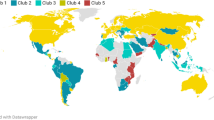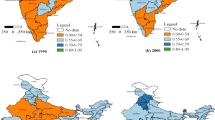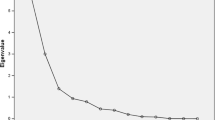Abstract
The study of club convergence has been a major focus in the field of economic growth and development. The paper analyses the club convergence hypothesis going beyond the traditional use of GDP per capita. In this study, we attempt to analyze the convergence club of 102 countries based on augmented index for measuring development. This index consists of seven major indicator of development namely education, health, access to water and sanitation, energy use, environment, standard of living and good governance. These indicators are aggregated through weights obtained from Principal Component Analysis (PCA). Using this index of development we analyzed the club formation and transitional behavior of 102 countries over a period of 1996–2015. The study confirms four final club and shows transition during 2008. Further, to understand the determinant of the club membership we used ordered logit model. The result suggested that initial level of development and globalisation are the major drives in determining the club.


Similar content being viewed by others
Notes
The most common practice while measuring development process is take the growth of per capita GDP as its proxy. However, authors like Sen (1983), Goossens and Mäkipää (2007), Stiglitz et al. (2009) and Schepelmann et al. (2010) have criticized the use of per capita GDP as a measure of development as the former fails to account for the overall progress in the economy which is far beyond what growth rates in income can capture.
For details refer Phillips and Sul (2007). Transition modeling and econometric convergence tests. Econometrica, 75(6), 1771–1855.
PCA is a technique of analysing and identifying patterns in data, and expressing the data in as to highlight their similarities and differences. It transforms a large number of correlated variables into smaller number of uncorrelated variables but retain the information in large set. These uncorrelated variables which are extracted from original set variables using their correlation matrix are called principle components.
References
Aghion, P., Howitt, P., & Mayer-Foulkes, D. (2005). The effect of financial development on convergence: Theory and evidence. The Quarterly Journal of Economics, 120(1), 173–222.
Aksoy, T., Taştan, H., & Kama, Ö. (2019). Revisiting income convergence in Turkey: Are there convergence clubs? Growth and Change, 00, 1–33.
Apergis, N., Ewing, B. T., & Payne, J. E. (2017). Introduction: Symposium on energy sector convergence. Energy Economics, 100(62), 335–337.
Apergis, N., Panopoulou, E., & Tsoumas, C. (2010). Old wine in a new bottle: Growth convergence dynamics in the EU. Atlantic Economic Journal, 38(2), 169–181.
Azariadis, C. (1996). The economics of poverty traps part one: Complete markets. Journal of Economic Growth, 1(4), 449–486.
Bai, C., Mao, Y., Gong, Y., & Feng, C. (2019). Club convergence and factors of per capita transportation carbon emissions in China. Sustainability, 11(2), 539.
Barrios, C., Flores, E., & Martínez, M. Á. (2019). Convergence clubs in Latin America. Applied Economics Letters, 26(1), 16–20.
Barro, R. J. (2016). Economic growth and convergence, applied to China. China & World Economy, 24(5), 5–19.
Barro, R. J., & Sala-i-Martin, X. (1992). Convergence. Journal of Political Economy, 100(2), 223–251.
Bartkowska, M., & Riedl, A. (2012). Regional convergence clubs in Europe: Identification and conditioning factors. Economic Modelling, 29(1), 22–31.
Basel, S., Gopakumar, K. U., & Rao, Prabhakara. (2020). Broad-based index for measurement of development. Journal of Social and Economic Development. https://doi.org/10.1007/s40847-020-00093-2.
Basel, S., & Rao, R. P. (2018). β—Convergence of real per capita GDP in BRICS economies. Indian Journal of Economics and Development, 14(2), 309–315.
Basu, S., & Weil, D. N. (1998). Appropriate technology and growth. The Quarterly Journal of Economics, 113(4), 1025–1054.
Baumol, W. J. (1986). Productivity growth, convergence, and welfare: What the long-run data show. The American Economic Review, 76(5), 1072–1085.
Blanco, F., Martin, V., & Vazquez, G. (2016). Regional house price convergence in Spain during the housing boom. Urban Studies, 53(4), 775–798.
Borsi, M. T., & Metiu, N. (2015). The evolution of economic convergence in the European Union. Empirical Economics, 48(2), 657–681.
Burnett, J. W. (2016). Club convergence and clustering of US energy-related CO2 emissions. Resource and Energy Economics, 46, 62–84.
Camarero, M., Castillo, J., Picazo-Tadeo, A. J., & Tamarit, C. (2013). Eco-efficiency and convergence in OECD countries. Environmental & Resource Economics, 55(1), 87–106.
Canova, F. (2004). Testing for convergence clubs in income per capita: a predictive density approach. International Economic Review, 45(1), 49–77.
Chen, L., Wan, A. T., Tso, G., & Zhang, X. (2018). A model averaging approach for the ordered probit and nested logit models with applications. Journal of Applied Statistics, 45(16), 3012–3052.
Dey, S. P., & Neogi, D. (2015). Testing sigma and unconditional beta convergence of GDP for SAARC countries: Can inclusion of China further consolidate the convergence? Global Business Review, 16(5), 845–855.
Dowrick, S., & DeLong, J. B. (2003). Globalization and convergence. In Globalization in historical perspective. University of Chicago Press, pp. 191–226.
Dreher, A. (2006). Does globalization affect growth? Evidence from a new index of globalization. Applied Economics, 38(10), 1091–1110.
Durlauf, S. N., & Johnson, P. A. (1995). Multiple regimes and cross-country growth behaviour. Journal of Applied Econometrics, 10(4), 365–384.
Fischer, M. M., & Stirböck, C. (2006). Pan-European regional income growth and club-convergence. The Annals of Regional Science, 40(4), 693–721.
Fritsche, U., & Kuzin, V. (2011). Analysing convergence in Europe using the non-linear single factor model. Empirical Economics, 41(2), 343–369.
Galor, O. (1996). Convergence? Inferences from theoretical models. The Economic Journal, 106(437), 1056–1069.
Ghosh, M., Ghoshray, A., & Malki, I. (2013). Regional divergence and club convergence in India. Economic Modelling, 30, 733–742.
Goossens, Y., Makipaa, A., Schepelmann, P., & Sand, I. (2007). Alternative progress indicators to gross domestic product (GDP) as a means towards sustainable development. Brussels: European Parliament, Policy Department A: Economic and Scientific Policy.
Hao, R. (2008). Opening up, market reform, and convergence clubs in China. Asian Economic Journal, 22(2), 133–160.
Herrerias, M. J. (2013). The environmental convergence hypothesis: Carbon dioxide emissions according to the source of energy. Energy policy, 61, 1140–1150.
Hitiris, T., & Nixon, J. (2001). Convergence of health care expenditure in the EU countries. Applied Economics Letters, 8(4), 223–228.
Islam, N. (2003). What have we learnt from the convergence debate? Journal of Economic Surveys, 17(3), 309–362.
Kim, Y. S., & Rous, J. J. (2012). House price convergence: Evidence from US state and metropolitan area panels. Journal of Housing Economies, 21, 159–186.
King, A., & Ramlogan-Dobson, C. (2016). Is there club convergence in Latin America? Empirical Economics, 51(3), 1011–1031.
Li, F., Li, G., Qin, W., Qin, J., & Ma, H. (2018). Identifying economic growth convergence clubs and their influencing factors in China. Sustainability, 10, 2588.
Lyncker, K., & Thoennessen, R. (2017). Regional club convergence in the EU: Evidence from a panel data analysis. Empirical Economics, 52(2), 525–533.
Mankiw, N. G., Romer, D., & Weil, D. N. (1992). A contribution to the empirics of economic growth. The Quarterly Journal of Economics, 107(2), 407–437.
Martin, V., & Vazquez, G. (2015). Club convergence in Latin America. The BE Journal of Macroeconomics, 15(2), 791–820.
Monfort, M., Cuestas, J. C., & Ordonez, J. (2013). Real convergence in Europe: a cluster analysis. Economic Modelling, 33, 689–694.
Montañés, A., Olmos, L., & Reyes, M. (2018). Has the Great Recession affected the convergence process? The case of Spanish provinces. Economic Modelling, 68, 360–371.
Panopoulou, E., & Pantelidis, T. (2009). Club Convergence in Carbon Dioxide Emissions. Environmental & Resource Economics, 44, 47–70.
Panopoulou, E., & Pantelidis, T. (2012). Convergence in per capita health expenditures and health outcomes in the OECD countries. Applied Economics, 44(30), 3909–3920.
Parente, S. L., & Prescott, E. C. (1994). Barriers to technology adoption and development. Journal of Political Economy, 102, 298–321.
Parker, S., & Liddle, B. (2017). Analysing energy productivity dynamics in the OECD manufacturing sector. Energy Economics, 67, 91–97.
Perez-Sebastian, F. (2000). Transitional dynamics in an R&D-based growth model with imitation: comparing its predictions to the data. Journal of Monetary Economics, 45(2), 437–461.
Phillips, P. C., & Sul, D. (2003). Dynamic panel estimation and homogeneity testing under cross section dependence. The Econometrics Journal, 6(1), 217–259.
Phillips, P. C., & Sul, D. (2007). Transition modeling and econometric convergence tests. Econometrica, 75(6), 1771–1855.
Phillips, P. C., & Sul, D. (2009). Economic transition and growth. Journal of Applied Econometrics, 24(7), 1153–1185.
Quah, D. (1993). Galton’s fallacy and tests of the convergence hypothesis. The Scandinavian Journal of Economics, 95(4), 427–443.
Quah, D. T. (1995). Empirics for economic growth and convergence. European Economic Review, 40(6), 1353–1375.
Quiroga, P. A. B. (2011). Convergence clubs in Latin America: a historical approach. Development Research Working Paper Series. Institute for Advance Development Studies.
Rodríguez-Benavides, D., López-Herrera, F., & Venegas-Martínez, F. (2014). Are there economic convergence clubs in Latin America? Journal of Economics and Development Studies, 2(3), 113–123.
Schepelmann, P., Goossens, Y., & Makipaa, A. (2010). Towards sustainable development: Alternatives to GDP for measuring progress. (No. 42). Wuppertal Spezial.
Schnurbus, J., Haupt, H., & Meier, V. (2017). Economic transition and growth: a replication. Journal of Applied Economics., 32, 1039–1042.
Sen, A. (1983). Development which way now? The Economic Journal, 93(372), 745–762.
Solow, R. M. (1956). A contribution to the theory of economic growth. The Quarterly Journal of Economics, 70(1), 65–94.
Stiglitz, J., Sen, A. K., & Fitoussi, J. P. (2009). The measurement of economic performance and social progress revisited: Reflections and overview. OFCE Working Paper. New York, NY: Columbia University.
Tam, P. S. (2018). Economic transition and growth dynamics in Asia: Harmony or discord? Comparative Economic Studies, 60(3), 361–387.
Tian, X., Zhang, X., Zhou, Y., & Yu, X. (2016). Regional income inequality in China revisited: a perspective from club convergence. Economic Modelling, 56, 50–58.
Todaro, M. P., & Smith, S. C. (2011). Economic development (11th ed.). Essex: Pearson Education Limited.
Vojinović, B., Acharya, S., & Próchniak, M. (2009). Convergence analysis among the ten European transition economies. Hitotsubashi Journal of Economics, 50, 123–141.
Wang, Z., Liu, H., & Zhang, T. (2014). Optimal computational and statistical rates of convergence for sparse nonconvex learning problems. Annals of Statistics, 42(6), 2164.
World Bank database. (2018). Retrieved from https://databank.worldbank.org/data/source/world-development-indicators#.
Acknowledgements
The authors would like to thank the editor and the anonymous referees for their valuable suggestions that helped to improve the manuscript.
Author information
Authors and Affiliations
Corresponding author
Additional information
Publisher's Note
Springer Nature remains neutral with regard to jurisdictional claims in published maps and institutional affiliations.
Appendices
Appendices
Appendix 1
Indicators | Variables | Weights |
|---|---|---|
Education | Expected year of schooling (years) | 0.079 |
Mean year of schooling (years) | 0.080 | |
Health | Life expectancy at birth, total (years) | 0.080 |
Infant mortality rate (per 1000, live birth) | 0.079 | |
Access to water and sanitation | Improved sanitation facilities (percentage of population with access) | 0.080 |
Improved water facilities (percentage of population with access) | 0.078 | |
Energy use | Non-renewable energy consumption (kg of oil equivalent per capita) | 0.079 |
Renewable energy consumption (percentage of total final energy consumption) | 0.058 | |
Environment | Forest cover (km2) | 0.078 |
CO2 emissions (Kt) | 0.077 | |
Standard of living | y–o-y GDP per capita growth (in percentages) | 0.052 |
y–o-y Inflation, consumer prices (in percentages) | 0.032 | |
Gross capital formation (percentage of GDP) | 0.047 | |
Good governance | Rule of law (in percentiles) | 0.045 |
Voice and accountability (in percentiles) | 0.056 |
Appendix 2
Variables | Club 1 | Club 2 | Club 3 | Club 4 |
|---|---|---|---|---|
Expected year of schooling (years) | 13.70 | 12.97 | 12.48 | 11.57 |
Mean year of schooling (years) | 8.79 | 8.44 | 7.79 | 7.16 |
Life expectancy at birth, total (years) | 71.87 | 72.49 | 69.99 | 62.72 |
Infant mortality rate (per 1000, live birth) | 22.87 | 21.63 | 27.83 | 47.15 |
Improved sanitation facilities (percentage of population with access) | 84.24 | 76.13 | 71.45 | 55.29 |
Improved water facilities (percentage of population with access) | 92.52 | 88.57 | 89.54 | 76.04 |
Non-renewable energy consumption (kg of oil equivalent per capita) | 144.31 | 141.16 | 151.83 | 297.42 |
Renewable energy consumption (percentage of total final energy consumption) | 27.47 | 25.50 | 31.56 | 49.96 |
Forest cover (km2) | 132,288.07 | 318,761.72 | 704,129.31 | 426,327.16 |
CO2 emissions (Kt) | 145,160.40 | 359,156.79 | 188,138.07 | 112,346.65 |
y–o-y GDP per capita growth (in percentages) | 1.86 | 2.85 | 2.12 | 3.23 |
y–o-y Inflation, consumer prices (in percentages) | 9.75 | 7.66 | 7.45 | 308.59 |
Gross capital formation (percentage of GDP) | 24.29 | 24.42 | 23.58 | 22.76 |
Rule of law (in percentiles) | 63.55 | 51.84 | 50.18 | 31.91 |
Voice and Accountability (in percentiles) | 55.79 | 54.42 | 51.88 | 34.51 |
Rights and permissions
About this article
Cite this article
Basel, S., Gopakumar, K.U. & Prabhakara Rao, R. Testing club convergence of economies by using a Broad-Based Development Index. GeoJournal 86, 2351–2365 (2021). https://doi.org/10.1007/s10708-020-10198-0
Published:
Issue Date:
DOI: https://doi.org/10.1007/s10708-020-10198-0




